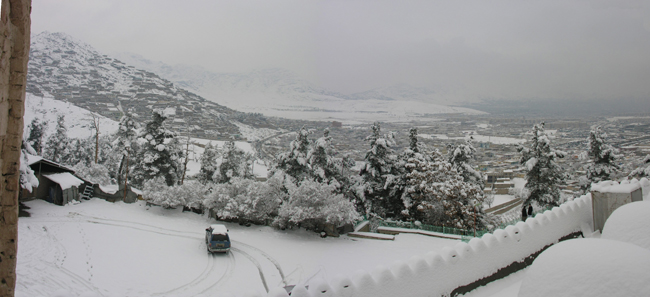
The day before it started snowing in Kabul, the shopkeepers had the wooden snow shovels out for sale, knowing that they would come in handy. And it snowed with a vengeance, massive flakes the size of large coins came down. Kabul is a city of flat roofs and everyone, young and old, got busy climbing up and shoveling the white stuff off onto the sidewalks, where passersby played cat and mouse games with heaps of snow crashing down on them. Pretty soon it got real slippery, too. No one salts the roads or even spreads sand, so walking became an exercise of tentatively putting one foot in front of the other to test the ground for traction. Quite often, especially down some of the steep footpaths between the mud walled homes in the hills some old man walking ahead of me would slip and fall backwards, sending whatever goods he had on him flying into the air. Cars faced similar obstacles and sometimes I observed some of the more degenerated roads to be nearly impassable when the snowy slush mixed with mud, got compacted by tires, and then turned to solid ice overnight. Traffic slowed to a yawning crawl, not that it hasn’t already been reduced to a crawl on a daily basis by the small roads and large number of cars. On the positive side, all the dust kicked up by cars navigating disintegrated streets, has been completely wiped out from the air and locked into the muddy, icy ground until the season turns.
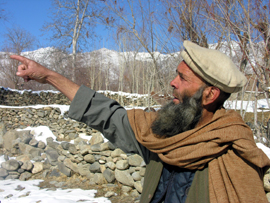 For two solid days it snowed and then one morning I woke to a deeply frozen but brilliantly sunny Kabul. The mighty Hindukush Mountains that surround the city seemed even more white than before and all the local hills and slopes emerged in the same state of brilliant white. For us in the little guesthouse and for most other people in the city, the deep freeze meant the end of free flowing water in the bathrooms, because all pipes had frozen or even burst. The ones leading to our tap burst. I initially griped at the thought of not having water, but then our trusty driver told us that on the way over he saw an old man living in a little shack by the side of the road nearby frozen to death. The News reported that 70 people so far had died in Kabul alone from exposure to cold. I stopped complaining. I’m not surprised, considering that the more poverty stricken people live virtually out in the open; their shelters of mud brick don’t have windows or any other insulation from the cold and -20 degrees Celsius at night can get lethal.
For two solid days it snowed and then one morning I woke to a deeply frozen but brilliantly sunny Kabul. The mighty Hindukush Mountains that surround the city seemed even more white than before and all the local hills and slopes emerged in the same state of brilliant white. For us in the little guesthouse and for most other people in the city, the deep freeze meant the end of free flowing water in the bathrooms, because all pipes had frozen or even burst. The ones leading to our tap burst. I initially griped at the thought of not having water, but then our trusty driver told us that on the way over he saw an old man living in a little shack by the side of the road nearby frozen to death. The News reported that 70 people so far had died in Kabul alone from exposure to cold. I stopped complaining. I’m not surprised, considering that the more poverty stricken people live virtually out in the open; their shelters of mud brick don’t have windows or any other insulation from the cold and -20 degrees Celsius at night can get lethal.
But what a bright city Kabul during winter is, just like Khaled Hosseini, the author of The Kite Runner, had described in his best selling novel. The sky, after it cleared, became a deep blue and everyone’s eyes were reduced to squinting in the bright light. Sure enough, I saw kites rising into the blue, sometimes zig zagging, sometimes sweeping graceful arcs, but always quick to engage one another in a duel.
On one of those bright days, Waheed and I jumped inside the toasty interior of our trusty Landcruiser and asked Sayed, the driver with the benevolent eyes, to drive us north over the Khairkhana Pass and out of the city. Kabul has expanded recently and most of that seems to be up into the hills. On our drive north we noticed that once barren hillsides were packed with rectangular tan and brown mud brick houses all the way up to where hills turned into steep rock. Over the pass and beyond it, another massive and long valley known as Kodaman opened up and we drove down the newly paved black top past low slung villages set amid walnut and mulberry trees and grape vines. Everything was dormant and buried under a thick coat of snow. On either side of the valley, the tall ridges of the Hindukush rose. Back in the old days, before the massive bombing campaigns of the Russians that were aimed at all the villages in the valley, the road used to be lined with trees. Today the road was lined with the tattered green flags flying over the grave stones of all the local people who died during the war years.
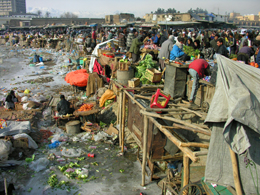 From the various villagers I found out that only Afghans who fought for Kodaman received the honor of a green martyr’s flag. The Russians, the Taliban, the foreign fighters, they all were buried in unmarked ditches to be replanted with the very trees that got destroyed. Or goal that day was to look up a patch of agricultural land, a few dozen acres maybe, that had been owned by my family for decades, but completely neglected in the last twenty five years of our exile from Afghanistan. Happily, we found rows and rows of dormant grapes waiting for the spring thaw under their blanket of snow. But sadly, our family compound, a two story house surrounded by a courtyard and high walls and even an outdoor swimming pool, had been completely leveled. What used to be the house was a disintegrating heap of brick and dirt and the remnants of some high mud brick wall. Only two bullet pocked walls of the swimming pool remained. It looked like a tank had wedged itself inside of it at some point in the last couple of decades.
From the various villagers I found out that only Afghans who fought for Kodaman received the honor of a green martyr’s flag. The Russians, the Taliban, the foreign fighters, they all were buried in unmarked ditches to be replanted with the very trees that got destroyed. Or goal that day was to look up a patch of agricultural land, a few dozen acres maybe, that had been owned by my family for decades, but completely neglected in the last twenty five years of our exile from Afghanistan. Happily, we found rows and rows of dormant grapes waiting for the spring thaw under their blanket of snow. But sadly, our family compound, a two story house surrounded by a courtyard and high walls and even an outdoor swimming pool, had been completely leveled. What used to be the house was a disintegrating heap of brick and dirt and the remnants of some high mud brick wall. Only two bullet pocked walls of the swimming pool remained. It looked like a tank had wedged itself inside of it at some point in the last couple of decades.
The entire apple tree orchard that surrounded the house at one time had disappeared completely. The resident farmers told us that the various trenches around the house were dug by the Taliban in the mid nineties as they fought their way through to Kabul. According to the farmers, there are quite a few Taliban fighters buried in and around this area in unmarked pits. The two local farming families had been squatting on the land for over two decades now and slowly brought it back to life. Waheed enlisted them to go even further and remove what’s left of the war rubble, fill the trenches and get a new apple and pomegranate orchard started again. There is no use trying to evict these families. Besides the obvious cruelty, they seem to be good stewards of the land, as long as they can conduct their lives in peace.
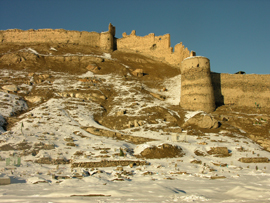 Another family property outside of Kabul fared similarly: it was utterly and completely destroyed by Russian jets in the 1980’s during their campaign to break the support system and the will of the freedom fighters or resistance fighters or whatever you want to call the local farmers who were forced to take up arms. To arrive here, we drove west out of Kabul up a broadly sloping alluvial plain, and then further uphill along the fast flowing Paghman River lined with great rounded boulders tossed downstream by the untamed waters. Soon Kabul was left behind, a couple thousand feet below, and the little town of Paghman appeared into view, beautifully nestled in a deep canyon amid spectacularly rising white mountains. A very dangerous beauty, however: landmines still litter parts of this region. UN minesweepers have cleaned out the valley but the hillsides are mostly off limits to neophytes like me. Now another collection of flat roofed and brown mud brick houses, this spot was known among the Kabul residents, who came here in the summer to escape the heat, as a little Switzerland. Steeply pitches rooflines, brown gables, white paint, and windows with flower pots set this little paradise apart from anything else in and around Kabul. None of that is left. But even here, among ice and snow filled bomb craters, the reconstruction has resumed.
Another family property outside of Kabul fared similarly: it was utterly and completely destroyed by Russian jets in the 1980’s during their campaign to break the support system and the will of the freedom fighters or resistance fighters or whatever you want to call the local farmers who were forced to take up arms. To arrive here, we drove west out of Kabul up a broadly sloping alluvial plain, and then further uphill along the fast flowing Paghman River lined with great rounded boulders tossed downstream by the untamed waters. Soon Kabul was left behind, a couple thousand feet below, and the little town of Paghman appeared into view, beautifully nestled in a deep canyon amid spectacularly rising white mountains. A very dangerous beauty, however: landmines still litter parts of this region. UN minesweepers have cleaned out the valley but the hillsides are mostly off limits to neophytes like me. Now another collection of flat roofed and brown mud brick houses, this spot was known among the Kabul residents, who came here in the summer to escape the heat, as a little Switzerland. Steeply pitches rooflines, brown gables, white paint, and windows with flower pots set this little paradise apart from anything else in and around Kabul. None of that is left. But even here, among ice and snow filled bomb craters, the reconstruction has resumed.
Although the great pines and aspen that I still remember growing among the tumbled boulders of the Paghman River have all but gone, there is a new crop of young trees and shrubs going up everywhere. The only sad thing is the issue of landmines in the hillsides. Abraham, a close family friend from the old days, who still lives in the canyon with his family and tends to the property, recounted how every now and then a sheep among the flocks that roam the nearby hills beyond the river gets blown to bits by a mine that’s still active after all these years. In fact they let the sheep act as a sort of minesweeper. Once even a wolf belonging to a pack that occasionally roams the valley for prey in the winter, was blown into pieces by a mine. As revolting as I find that, it’s still better than one of Abraham’s kids losing life or limb. He has already lost his first six children (three boys and three girls) to the Russians and Taliban. But that’s a heart rending story in itself that I will leave untold for now. Let it suffice to say that savage brutality and carnage happened among these hauntingly beautiful mountains of pure white.
By now Waheed and I have left our native city of Kabul, its bright sky, the noisy bazaars along the banks of the Kabul River, the utterly chaotic traffic, and its ruthlessly cold winter air for the balmy land of peace and law and order that is California. We even squeezed a week in northern India before our return to America, but I will leave that huge ancient country for another travelogue. Now the temptation is to return to Afghanistan during the warmer seasons, to explore the land far beyond Kabul. Even though I was born there, it is a whole undiscovered world for me and I yearn to go back and wander among fellow Farsi speaking people again. And to witness the slow and sometimes painful rebirth of my old homeland again.
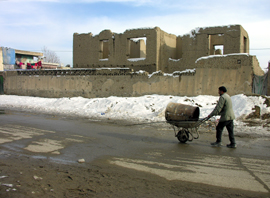
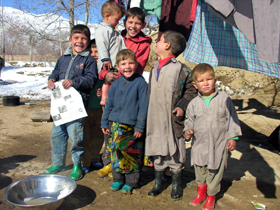

Some fail to realize that places in the middle east are beautiful places to visit. It is such a pity that some of them are torn apart by war.
Take me here someday, big brother
I’m ready to go there NOW – actually, not now as in now, but during the warmer months later this year would be fine.